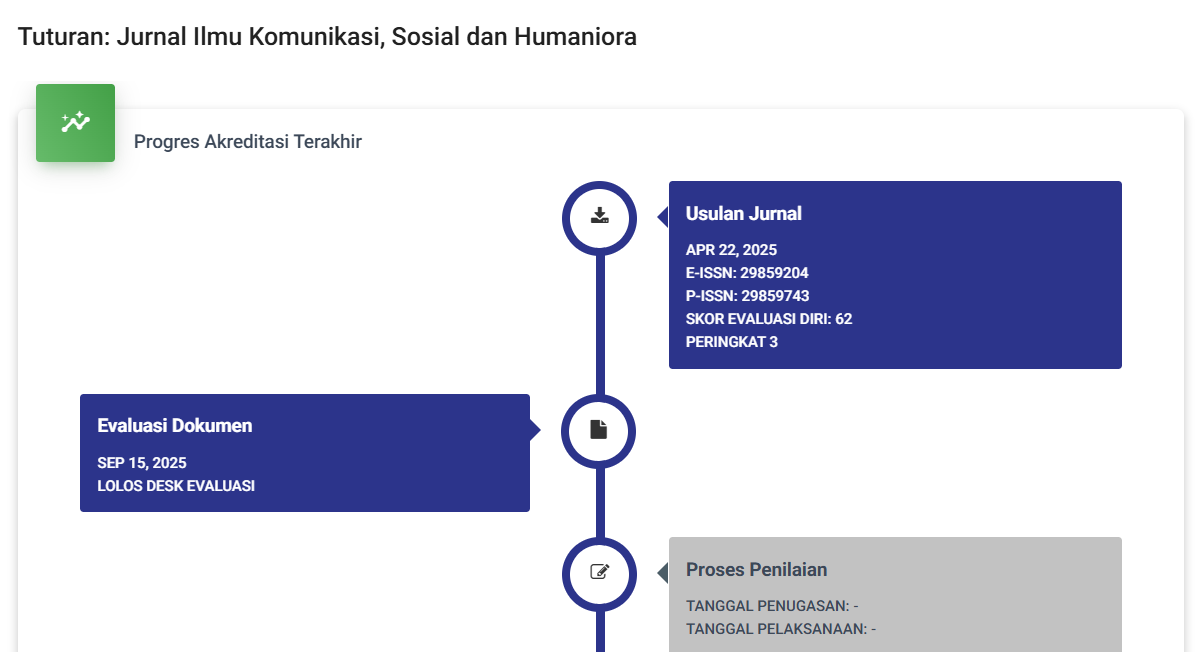Perilaku Komunikasi Remaja Dengan Orang Tua Dalam Penggunaan Produk Virtual Dalam Game Online Mobile Legends: Bang Bang
DOI:
https://doi.org/10.47861/tuturan.v2i1.758Keywords:
Communication Behavior, Teenager, Parent, Virtual Product, Online Game, Mobile Legends: Bang BangAbstract
This study aims to determine the motives of teenagers in purchasing and using virtual products in the Mobile Legends: Bang Bang online game, teenagers' communication experience in using virtual products in Mobile Legends: Bang Bang, and teenagers' communication behavior with parents in using virtual products in Mobile Legends: Bang Bang. This research uses a qualitative phenomenological approach with Phenomenology Theory. Data collection techniques in this research is using in-depth interviews and observation. Informant selection in this research is using purposive sampling technique. Then, data analysis in this research is using the Miles & Huberman interactive analysis technique. The results showed that there are two motives for teenagers to buy and use virtual products in the Mobile Legends: Bang Bang, namely because-motive which includes the appearance and aesthetics of virtual products, playing and liking heroes from virtual products, not wanting to be inferior to the surrounding environment, and in-order-to motive which includes to improve playing skills, to show off their virtual products, and to gain a sense of prestige and recognition from the surrounding environment. Communication experiences experienced by teenagers in using virtual products are divided into three, namely with parents, the environment, and themselves, all three of which tend to be positive communication experiences. Then, there are meanings about virtual products and relationships between teenagers and parents formed from communication behavior between them regarding the use of virtual products, teenagers interpret virtual products as pride, self-reward, investment, personalization, hobbies, lifestyle, and teenagers interpret their relationship with their parents as encouragement, good communication, parental affection, and reciprocal relationships.
References
Clement, J. (2022, December 7). Most downloaded mobile MOBA gaming titles 2022 | Statista. Statista. https://www.statista.com/statistics/1269466/most-downloaded-moba-apps-worldwide/
Dyulgerova, H., & Devreli, P. (2019). Hedonic Motives : Influencing players’ impulse buying purchases of virtual goods (Issue May).
Fan, W. (2019). Motivational Factors on Purchase Intention of in-Game Hero Skins in Moba Games. Journal, December, 55.
George-Gabriel, R., & Anastasia, K. (2022). What Aspects of Gacha Games Keep the Players Engaged? June. https://urn.kb.se/resolve?urn=urn:nbn:se:uu:diva-475987
Gillis, A. S. (2021). What is IoT (Internet of Things) and How Does it Work? https://www.techtarget.com/iotagenda/definition/Internet-of-Things-IoT
Haryanto, Sindung. (2012). Spektrum Teori Sosial. Jogjakarta: AR-RUZ MEDIA.
Hidayat, M. (2023, January 20). 35 Persen Pendapatan Mobile Legends pada 2022 di Asia Tenggara Berasal dari Indonesia.
Hjorth, L., & Richardson, I. (2014). Gaming in social, locative and mobile media. In Gaming in Social, Locative and Mobile Media (Issue January). https://doi.org/10.1057/9781137301420
Johnson, D., Nacke, L. E., & Wyeth, P. (2015). All About That Base: Differing Player Experiences in Video Game Genres and the Unique Case of MOBA Games. CHI ’15: Proceedings of the 33rd Annual ACM Conference on Human Factors in Computing Systems. https://doi.org/https://doi.org/10.1145/2702123.2702447
Kaunang, K. I., & Pangemanan, S. S. (2018). the Effectiveness of in-Application Purchases on Mobile Applications (Case Study At Mobile Games Application). The Effectiveness…… 918 Jurnal EMBA, 6(2), 918–927.
Kuppens, S., & Ceulemans, E. (2018). Parenting Styles: A Closer Look at a Well-Known Concept. Journal of Child and Family Studies, 28(1), 168–181. https://doi.org/doi: 10.1007/s10826-018-1242-x
Kuswarno, E. (2009). Fenomenologi. Bandung: Widya Padjadjaran.
Littlejohn, S. W., & Foss, K. A. (2009). Encyclopedia of Communication Theory (S. W. Littlejohn & K. A. Foss (eds.)). California: SAGE Publications, Inc.
Moleong, L. J. (2018). Metodologi Penelitian Kualitatif. Bandung: PT Remaja Rosdakarya.
Muhonen, M. (2015). Mobile in-Application Purchasing : a Consumer Perspective.








